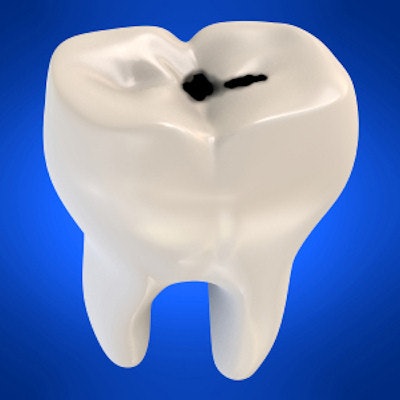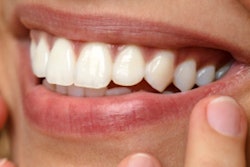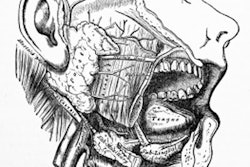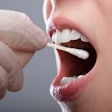
Are biological markers present in saliva that might indicate that a child is at risk of developing caries? Not according to the results of a new study. However, the researchers went on to investigate whether a more complex analysis could better predict caries risk.
Researchers from Europe examined the composition of saliva and the dental health of preschool-aged children and found that no single attribute foretold the occurrence of caries (Scientific Reports, January 24, 2018). However, when they combined in a statistical analysis the types of bacteria and antimicrobials present in the saliva of children at age 4, this model predicted and grouped the children who developed caries one year later.
"Our data suggest that there are similarities in the interaction between the types of bacteria and immune defenses that may predispose to the development of dental caries," study co-author Jennifer Malcolm, PhD, told DrBicuspid.com. Malcolm is a biomedical sciences lecturer at the Glasgow Dental School at the University of Glasgow in the U.K.
Predicting the future
Previous research has found that an individual's oral microbiome can vary measurably with age, stage of caries development, and site sampled. In addition, oral biofilm development is affected by environmental and behavioral factors, and susceptibility to oral disease is affected by host immune factors, including those in saliva, according to the authors.
In the current study, the investigators sought to determine the types of bacteria present in the mouths of healthy, caries-free children and whether these types of bacteria changed as these children developed carious lesions.
“There are similarities in the interaction between the types of bacteria and immune defenses that may predispose to the development of dental caries.”
"We conducted this study with the aim of identifying changes in the types of bacteria or levels of immune defenses that occur before the onset of carious lesions," Malcolm noted. "We wanted to identify biological markers that, if present, might indicate that a child is at risk of developing dental caries."
Immune defenses are antimicrobial defense proteins present in saliva, specifically the antimicrobial peptides LL37 and human neutrophil peptides (HNPs) 1-3 and lactoferrin, Malcolm explained. Previous research has suggested that these salivary antimicrobials may play a role in the development of oral infectious diseases, with low concentrations of HNPs 1-3 associated with increased caries incidence in adolescents and low LL37 linked to higher caries scores in young children.
The study included 33 children who were drawn from a larger study and attended one of 14 preschools in Glasgow, U.K. At baseline, they were all 4 years old, had no known chronic illnesses, and had not taken antibiotics during the previous three months. Additionally, they all had complete primary dentition, with no partially erupted permanent teeth and no missing teeth at baseline. All completed follow-up one year later.
The participating children underwent dental exams and provided salivary samples at baseline and one year later. The researchers recorded only caries into dentine. They collected unstimulated saliva using a child's oral swab (Salimetrics).
They divided the children into three groups with the following characteristics:
- Caries-free at baseline and follow-up (n = 14)
- Caries-free at baseline but developed one or more carious lesions by the follow-up exam (n = 5)
- One or more existing carious lesions at baseline (n = 14)
The researchers used DNA sequencing technology to identify the types of bacteria in the children's saliva and measured the levels of immune defenses present. When they compared the types of bacteria or levels of immune defenses in the saliva of the children who developed caries with those who didn't, they didn't find any statistically significant differences.
However, the types of bacteria present in the saliva of children changed dramatically according to their age when the sample was collected. A more diverse bacteria population was present in the children at age 5 than at age 4. Additionally, the levels of immune defenses were higher on average when the children were older.
"These results were not really that surprising to us; they just didn't reflect our primary question, which was to identify changes related to the onset of caries," Malcolm stated. "Rather our data reflect the normal maturation of the oral ecosystem."
The levels of immune defenses change as we age, she noted.
"From birth, babies immediately begin to acquire new types of bacteria in their mouths from their caregivers and their environment," she explained. "This process of oral evolution continues throughout our lifetimes. Similarly, the levels of immune defenses also change as we age and may reflect, at least partially, the changes in the types of bacteria present."
The researchers also performed another step, combining into a statistical model their data on the bacteria present in the children's saliva at age 4 with the levels of immune defenses present at the same age.
"The model successfully predicted and grouped the children who would later develop caries at age 5," Malcolm stated.
More children wanted
A caveat of the research was the relatively small number of participants who developed caries during the study, according to Malcom. She added that she and her colleagues would like to perform a larger study.
"By repeating a similar study with more participants, we would hope to have greater statistical power to identify the species of bacteria or immune defenses that potentially interact to modify caries risk," she noted.



















